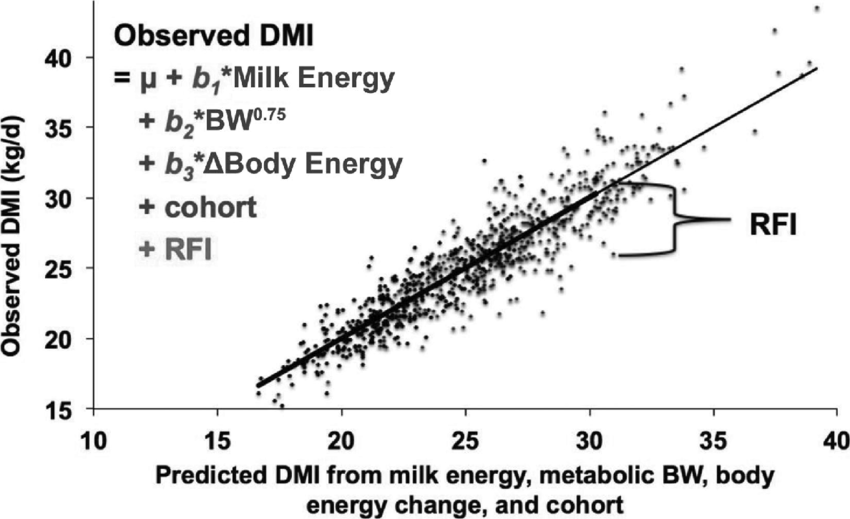The cattle industry is experiencing a quiet revolution, and it’s all about doing more with less. Across the country, forward-thinking ranchers are embracing Residual Feed Intake (RFI) testing as a groundbreaking tool to identify and breed more efficient cattle. But this isn’t just about producing more beef – it’s about producing it smarter, with scientific precision guiding every decision.
Understanding RFI: The Science Behind the Strategy
At its core, RFI is a sophisticated way to measure how efficiently an animal converts feed into beef. Think of it as a metabolic report card that compares how much feed an animal actually consumes versus how much we’d expect them to eat based on their size and growth rate. The difference between these numbers – that residual – reveals crucial information about an animal’s metabolic efficiency.
Let’s break down a real-world example that demonstrates why this matters: Consider two bulls of similar weight, both gaining 3.7 pounds per day. Traditional measures might suggest they’re equally efficient. However, RFI testing might reveal that while one bull consumes 24 pounds of feed daily, the other maintains the same growth rate on just 21.5 pounds. That 2.5-pound daily difference translates to substantial savings over time.
The Economics of Efficiency
The financial implications are striking. With feed costs representing up to 70% of total production costs, even small improvements in feed efficiency can have massive impacts on profitability. As Leo McDonnell, whose family pioneered RFI testing at Midland Bull Test, explains: “You’re talking $80 to $100 savings on the cow and another $100 to $125 on the steer. If you’ve got all your cattle bred like that, you don’t need the board. I guarantee you’ll make money.”
What makes RFI particularly valuable is its independence from other traits. Unlike traditional feed efficiency measures, selecting for improved RFI doesn’t negatively impact other important characteristics like:
- Fertility
- Milking ability
- Frame size
- Growth rate
- Carcass quality
This genetic independence means ranchers can improve feed efficiency without sacrificing the other traits they’ve worked so hard to develop in their herds.
The Technology Revolution
The technology behind RFI testing has evolved dramatically in recent years. Modern systems like GrowSafe allow for precise individual animal monitoring, collecting data on exactly how much feed each animal consumes and how efficiently they convert it to gain. These systems use electronic identification (EID) tags and sophisticated weight-sensing feed bunks to track:
- Individual feed intake
- Feeding duration
- Feeding patterns
- Weight gain
- Feed conversion efficiency
This level of precision was unimaginable just a few decades ago. Today’s systems can detect efficiency differences down to fractions of a pound, allowing for incredibly accurate selection decisions.

The Genetic Edge
What makes RFI particularly exciting from a breeding perspective is its heritability – about 40%, which is relatively high for production traits. Even more impressive is that there’s a 90% correlation between how a tested bull performs and how efficient his daughters will be in the cowherd. This means selecting bulls with favorable RFI values can have a lasting impact across generations.
Research has shown that both feed intake and RFI during the post-weaning period and at maturity have genetic correlations greater than 0.90. This suggests that selection decisions made based on post-weaning RFI measurements will translate almost perfectly to improved efficiency in the mature cow herd.
Implementation in Modern Ranching
For the ranching industry, this represents a fundamental shift in how we think about genetic selection. No longer are we just selecting for bigger or faster-growing animals – we’re selecting for animals that can do more with less. This shift is particularly important as the industry faces increasing pressure to reduce its environmental footprint while maintaining or improving productivity.
Many progressive ranchers are now implementing RFI testing as part of their regular breeding program evaluation. The process typically involves:
- Individual feed intake monitoring during a standardized test period
- Regular weight measurements to track growth
- Calculation of expected feed intake based on size and growth
- Comparison of actual versus expected intake
- Ranking of animals based on efficiency
- Selection decisions based on RFI values combined with other important traits
Looking to the Future
The future of cattle breeding lies in this intersection of science and traditional ranching knowledge. As we face growing pressure to produce more with less environmental impact, understanding and implementing RFI testing isn’t just about saving feed costs – it’s about building a more sustainable and efficient beef industry for the future.
The potential benefits are substantial:
- Reduced feed costs across the industry
- Lower environmental impact per pound of beef produced
- Improved profitability for ranchers
- More sustainable beef production systems
- Better resource utilization
Making It Work for Your Operation
For ranchers considering implementing RFI testing in their breeding program, it’s important to remember that this technology should complement, not replace, other important selection criteria. The goal is to build a balanced breeding program that produces efficient, productive, and profitable cattle.
Consider starting with:
- Testing your replacement bull battery
- Participating in RFI tests through reputable bull test stations
- Using RFI EPDs when available in your breed
- Collecting feed intake data on replacement females
- Tracking feed efficiency metrics in your operation
Want to learn more about implementing RFI testing in your operation? The science is clear – feed efficiency testing through RFI measurement represents one of the most promising tools for improving cattle production efficiency. As we continue to face challenges related to input costs and environmental sustainability, this technology will become increasingly valuable to progressive cattle operations.